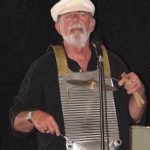Page Contents
When to Play
Joni Madden, the great Irish flutist, lost the rhythm bones player in her band and when asked why there was not a replacement, she replied, “There are so few good ones.” You do not have to be really good to play in public, but if you play poorly you give rhythm bones a bad name and may be asked embarrassingly to stop.
So how do you get good? Several leaders at the recent Bones Fest XXV said lots of practice. The late Jerry Mescher said it was the three Ds: Desire, Determination, Discipline. Instruction helps and there is much of it on our website.
Dave Boyles, great player and host of Bones Fest XI, wrote an article in our newsletter titled “Responsibilities of a Bones Player.” It is reprinted at the bottom of this page and is worth reading.
What made Russ Myers a great player? Russ’ main pattern was simple, two triplets followed by two doubles, and what made him great was his timing. How do you get good timing – repetition. Good music is its own metronome, but there is a metronome app for smartphones.
As a general rule, ask first. A question like, “Can I play one song with you to see if I fit in” can work. You are fitting in with them and not the other way around. However if they like your playing, you may get the nod to “show your stuff.”
Playing from the audience is rude.
Where to Play
Any where, any time, so keep a pair in your pocket, glove compartment, etc. If you get a chance, teach someone how to play.
Most every city or town in the world has places where local musicians gather weekly to ‘ jam’ that is, play together. A call to music stores or an ad in a newspaper might get you the location.
Music Festivals have formal programs, but most have people jamming all over the grounds.
Contra Dances. They always have a live band, and depending on the performers are usually open to Sit ins (see Steve Brown below).
Vacation trips such a cruises have talent shows, and you might win a prize. Ship bands are likely to let you join them if you are good.
Retirement homes and the like where people are hungry for entertainment and contact with other people. Note: You will need backup music and this can be other musicians or a smartphone with an inexpensive external speaker.
Irish Sessions are different – Don’t play unless you really know the music – See Steve Browns Irish Sessions
Drum circles – they will like you if you fit in.
Street Busking – See Celtic Kilroy’s Workshop

Responsibilities of a Bones Player
by Dave ‘Black Bart’ Boyles
The first time you develop and sense the vibrations of the bones in you hand, it feels good and you just want to keep shaking! It’s sooo therapeutic! However, that feeling and that sound, as fun as it is, is not so much fun for those unknowing souls around you. Historically “bones‟ have rated far down the line of recognized musical talents. Until you really get good at playing and can keep solid tempos, please be advised…I am simply warning all new bones players about this catharses. So I suggest the following responsibilities a bones player should adhere to so that our reputation is not downgraded anymore than history already has done.
Practice. To practice by yourself in you car, in the privy, in the garage or basement, on the lake or in the woods is very nice.
Partners. Your spouse can become very annoyed—unless, of course, you get that person their own pair of bones! Warning: It is not a good idea to shake them in your partner‟s face in the middle of an argument either!
Concerts & Pubs. Practice with recorded music when you can and nobody else is around. When you are in the audience don‟t just whip the bones out and play along with the band at your first concert or session. There is a courtesy to ask the musicians first because if your timing happens to be off it’s hard for the band to focus and they may tell you. When you’re ready, open sessions are a good place to start your public appearance. Approach it moderately until you know “you have it.”
Control. There’s a time to play and a time to sit out. The bones are a nice accent when played properly. Learn to play loud when the music is up and safe when it‟s down. Learn to vary the pattern. Stop periodically at the end of key phrases. Come back in on the chorus.
Final Responsibility. Finally, each bones player has a responsibility to police other players who get carried away (possibly after too much drink), to remind them of their bones manners when they appear obnoxious and especially if they have terrible rhythm.
A Steve Brown Story
One of the first places I played were fiddle contests. At that time there were a number of fiddle contests around, and there’s always a fair amount of jamming behind the stage in around the grounds. If people like you they may ask you to come up on stage with them. One of my earliest recordings is playing with fiddling slim at the Craftsbury all-time fiddlers contests.
Another possible location might be contra dances. They always have a live band, and depending on the performers are usually open to Sit ins. I been playing rhythm bones for six months when I wrote a letter to Dudley Laughman asking how I could get into playing the music, and letting him know I played rhythm bones. He wrote back, with a short sentence, “third Friday Carlisle be there.” I wondered in with my rhythm bones, and the first dance begin. When the dance ended Dudley leaned over to me and said, what are you doing tomorrow night?
